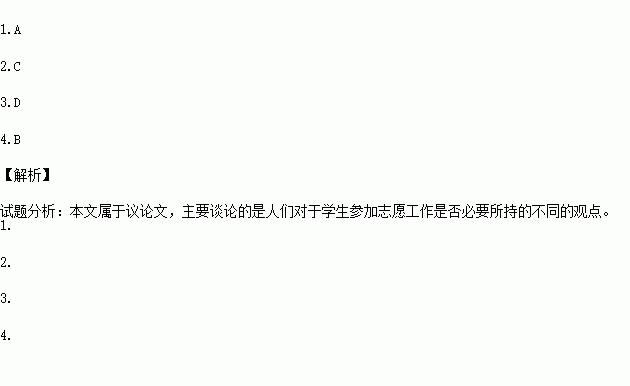题目内容
First Lady Michelle Obama is a big fan of volunteering. Volunteering means working for free to help someone else. Mrs. Obama says volunteering is very important. “It should be part of everyone’s life,” she says.
Many teens agree. They say that helping others feels great and makes a difference. These days, more teens volunteer than work for pay. Teens clean up parks, walk dogs at animal shelters, visit the elderly and more.
Some cities ---- including Seattle, Chicago, and Washington, D.C. ----require high school students to volunteer. Students must volunteer in order to graduate. The student volunteers learn new skills and help their communities.
Many parents are in favor of the idea ---- they say volunteering helps teens build job skills. But most teens don’t want to be forced to volunteer. They say they are busy. And they say volunteering is only fun if it’s a choice.
Read both sides of the debate and decide.
YES
Volunteering can help teens get into college or get a job.
Many cities and towns need help. Volunteers can help keep important programs going.
Not all teens will volunteer if it isn’ t required. Schools should require students to do all they can to get ready for adult life.
NO
Most teens are already very busy with classes, homework, jobs and sports. Forcing them to do more isn’t fair.
It should be up to each person. Helping out doesn’t feel as good if you have to do it.
Finding a volunteer job isn’t always easy. Students shouldn’t be kept from graduating because of something they can’t control.
1.The writer mentions Michelle Obama in order to___________.
A. introduce the topic of the text
B. explain what volunteering is
C. tell what she does for the US
D. show she enjoys volunteering
2.According to the text, in Chicago, .
A. finding a volunteer job is quite easy
B. more people would rather work for pay
C. volunteering is a must for high school students
D. college students have to volunteer before graduation
3.The underlined part “are in favor of” in the text means”.
A. dropB. developC. catchD. like
4.Which question does the text mainly discuss?
A. Is volunteering good for students?
B. Should students be required to volunteer?
C. What is the best time to volunteer?
D. Which volunteer jobs should students do?
 学而优衔接教材南京大学出版社系列答案
学而优衔接教材南京大学出版社系列答案We are a primary school in England. Our students start arriving at our playground from about 8:45 a.m. Most of the children live nearby, so they walk to school. But some children have to travel to school by car. Each of the children is dressed in a school uniform (校服) and carries the homework and packed lunch in a schoolbag.
School starts at 8:55 a.m. The teacher on duty blows a whistle (哨子) and the children line up in their class groups. They wait quietly for the teacher to send them to their classrooms. When they arrive at their classrooms, the children empty their schoolbags and put their homework in their boxes. After the children take their seats, the teacher reads out each child’s name in turn. Upon hearing his / her name, the child replies “yes, Mrs. (the teacher’s name)” and the teacher writes down whether the child is in school or not.
And then at 9:10 a.m. the children attend an assembly in our main hall. They sit on the floor in rows with the youngest children at the front and the older children at the back. As the children enter the hall, they listen to music quietly. Each week we have a different musical theme (主题). Besides, the children also listen to stories.
After the assembly, the first lesson of the day begins at 9:30 a.m. Our morning lessons are usually English and Maths. Each of these lessons lasts an hour. Between classes, the children have their morning break from 10:20 a.m. to 10:35 a.m. They eat their snacks (小吃) or play games like football on the playground. At the end of the break, the teacher on duty blows a whistle. The children stand still and wait to be told to line up.
Each day, the children have their lunch break from 12 noon to 1:10 p.m. Most of the children bring their own packed lunches from home. A packed lunch usually consists of sandwiches, fruit, a drink and a packet of crisps. Some children have a school dinner cooked in our school kitchen. While the children are waiting to have lunch or after they have finished eating, they play games on the playground or attend lunch-time clubs. We have teachers on duty, who look after the children during lunch breaks. After the lunch break, the children have afternoon lessons, which continue until 3:15 p.m. when the children go home.
A typical school day at a primary school in England | |
Paragraph outlines | Supporting details |
Arriving at school | ● The students start 1.______ the school playground from about 8:45 a.m. ● They come to school on 2.______ or by car. |
The start of school | ● At 8:55 a.m., the teacher on duty blows a whistle to make the children 3._____ up, and then sends them to their classrooms. ● The teacher 4.______ the attendance (出席) of each child. |
5.______ | ● At 9:10 a.m. the children attend an assembly in the main hall, where they listen to music or stories. ● They sit on the floor in rows at different6.______ according to their ages. |
Morning lessons | ● The first lesson of the day begins at 9:30 a.m. and each class lasts as 7.______ as an hour. ● The morning lessons are usually English and Maths. ● The morning break is from 10:20 a.m. to 10:35 a.m., when the children eat their snacks or play games. |
Lunch breaks and afternoon lessons | ● The lunch break starts at 12 noon and 8.______ at 1:10 p.m. ● During the lunch break, the students 9._____ lunch and play games or attend lunch-time clubs. ● School is 10._____ at 3:15 p.m. |

